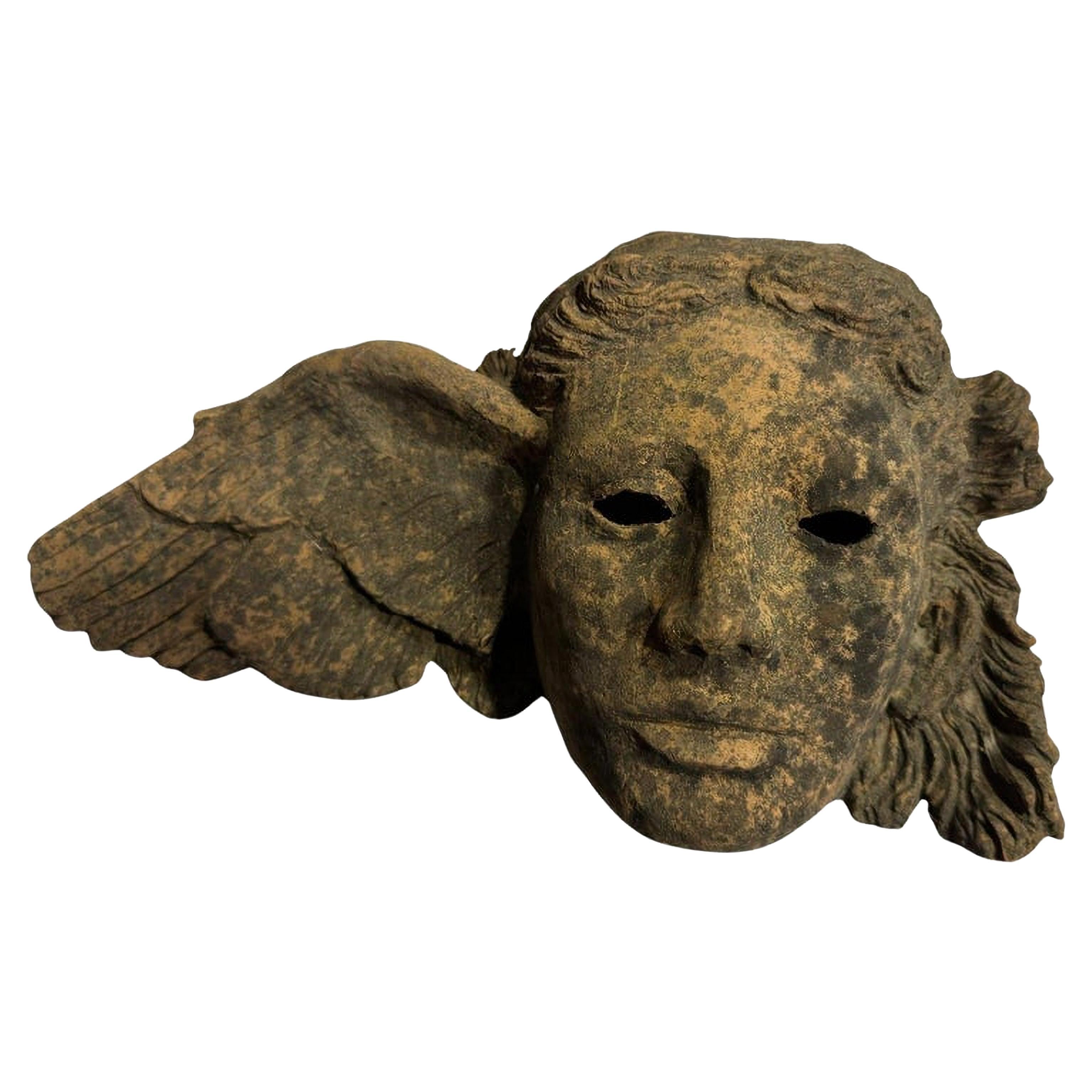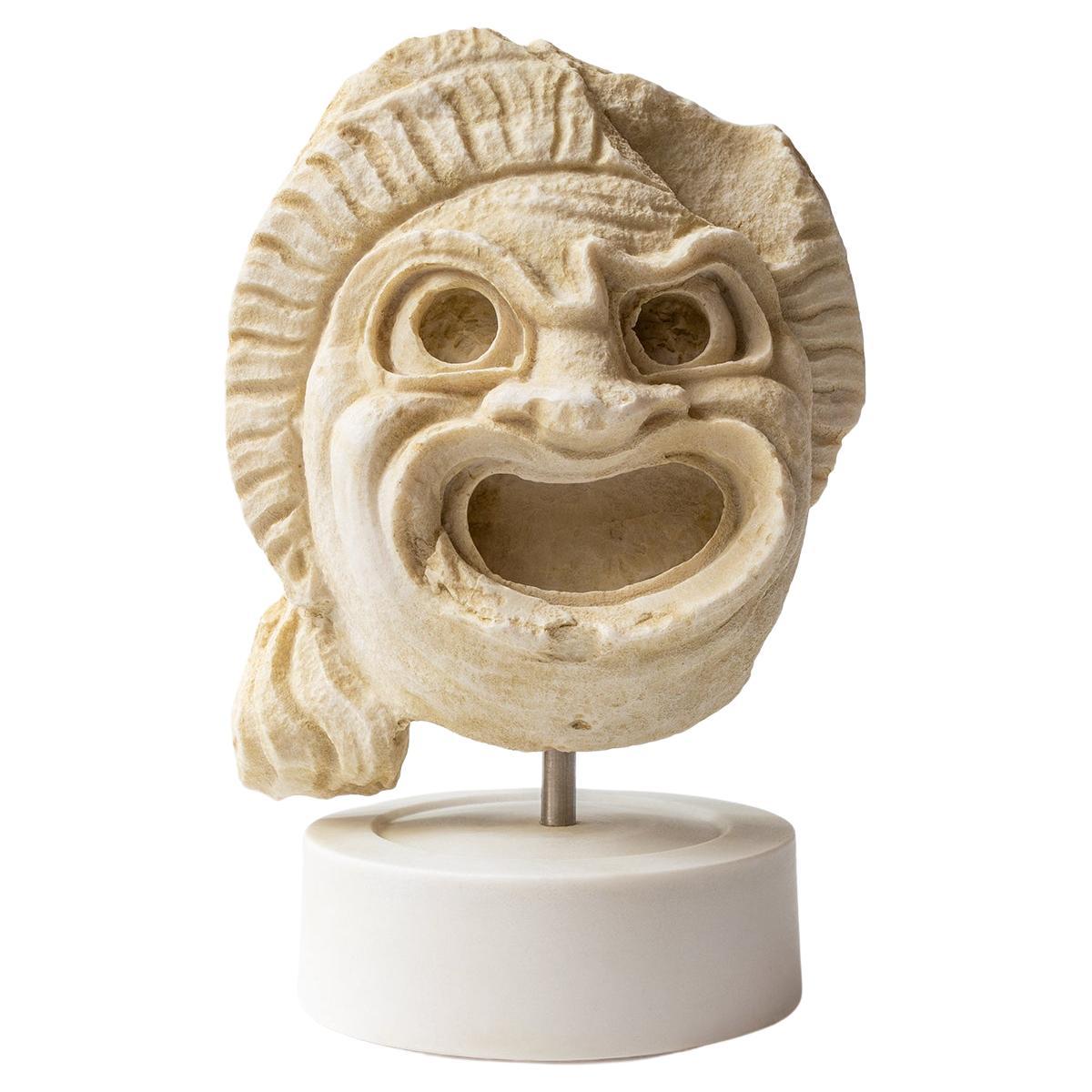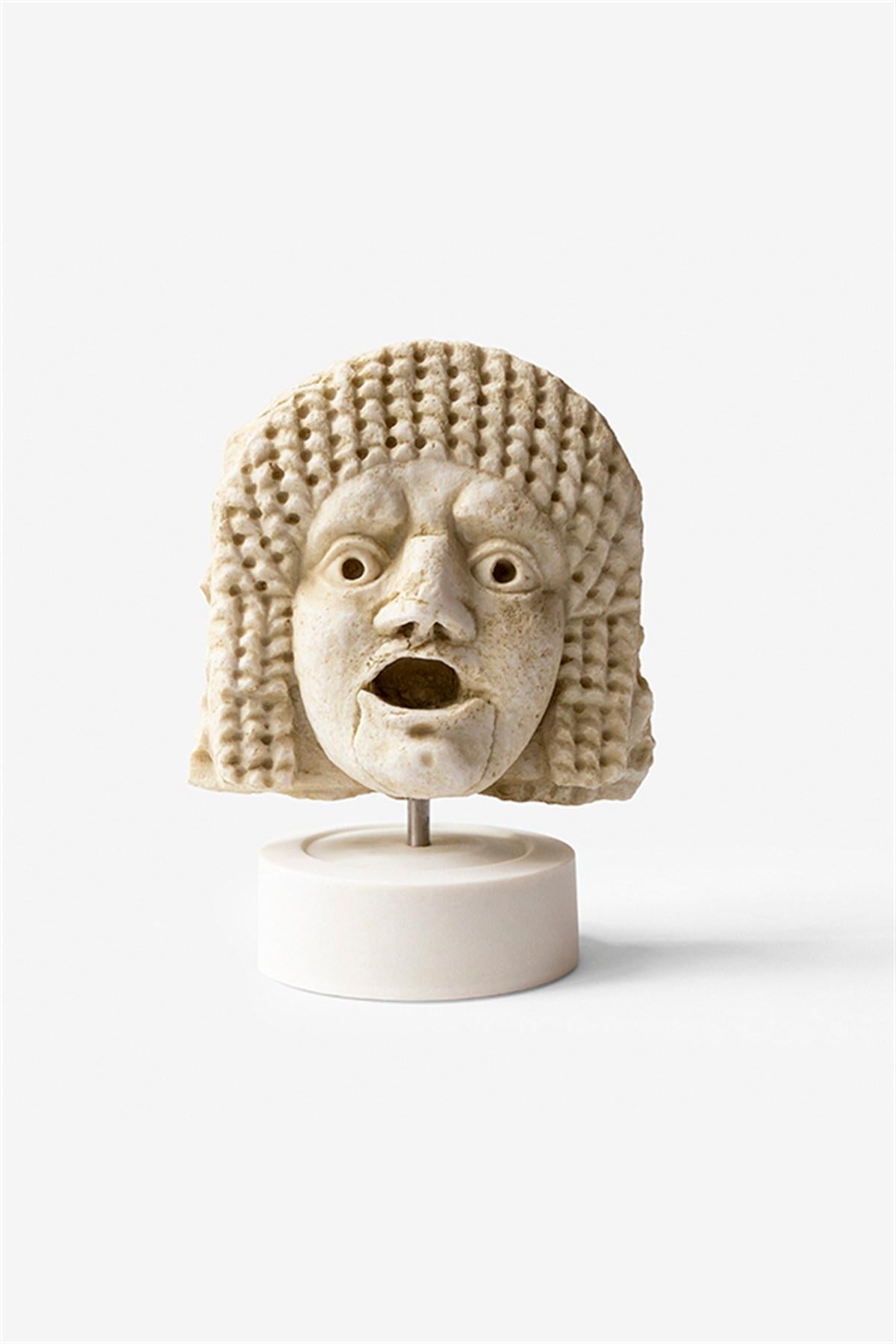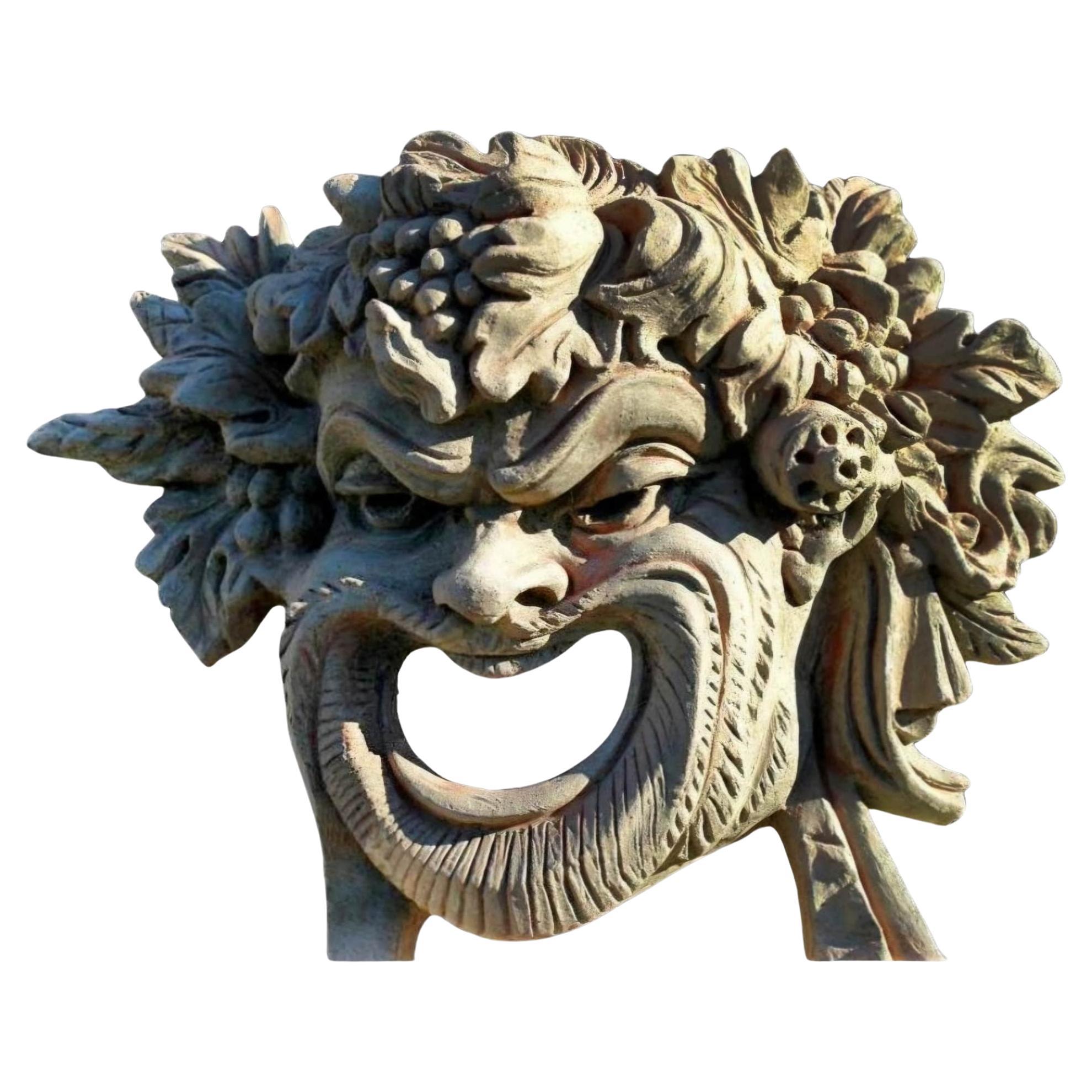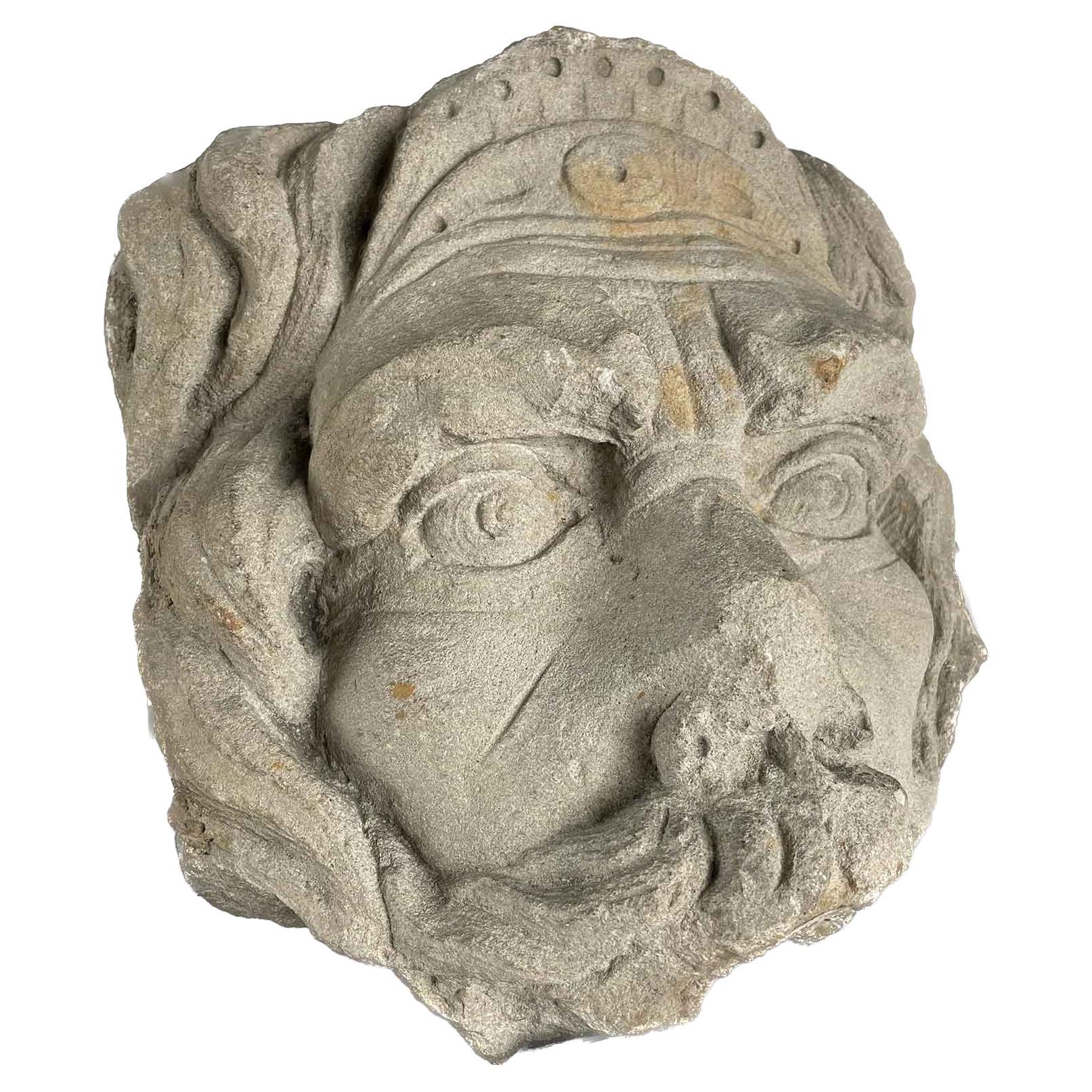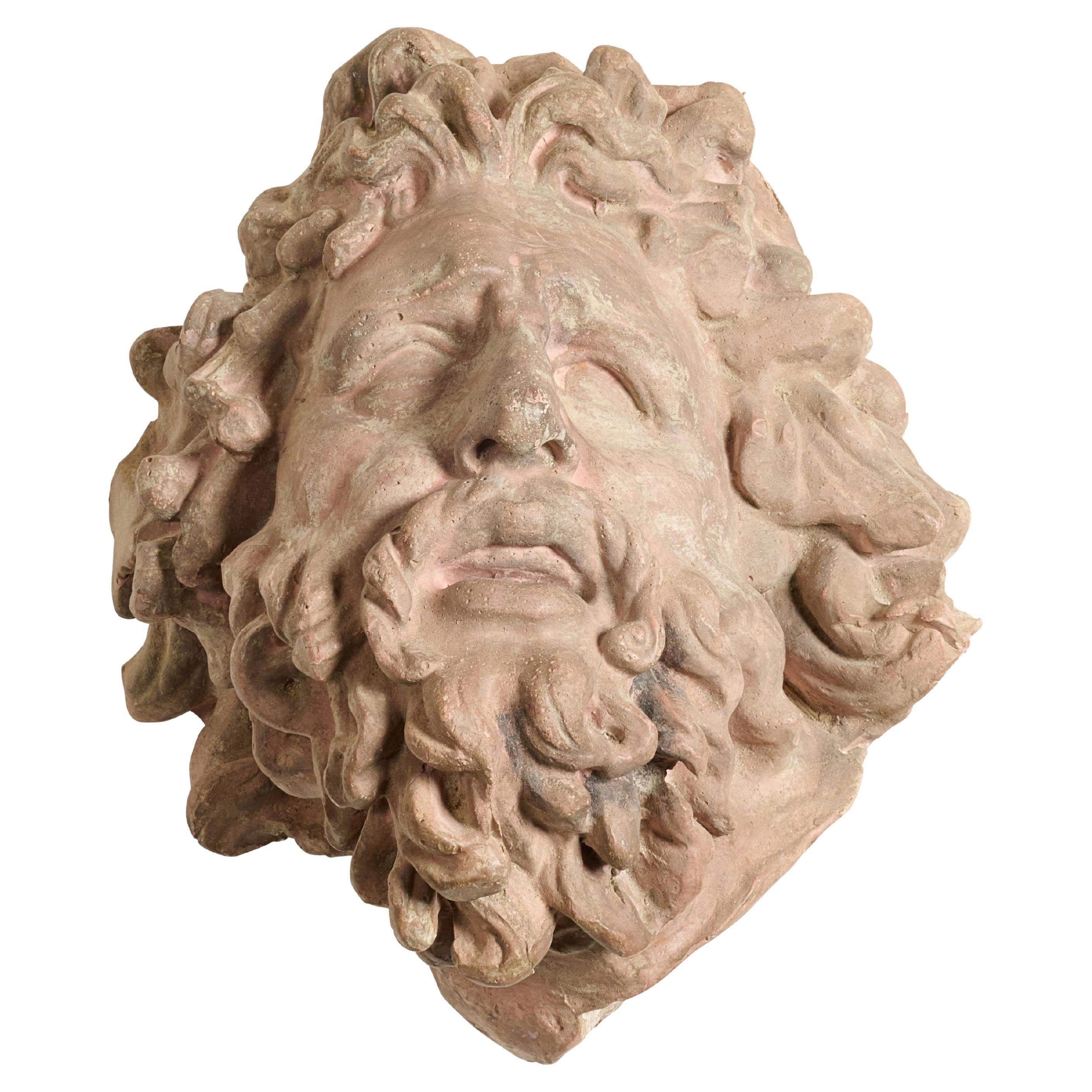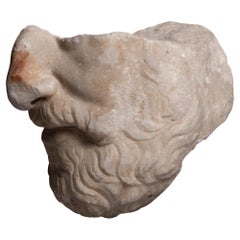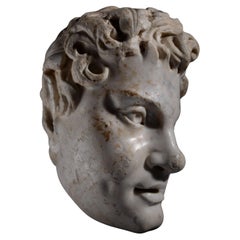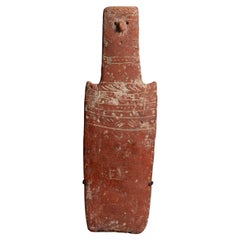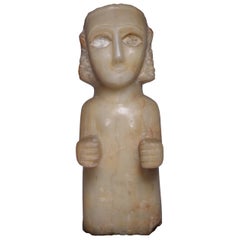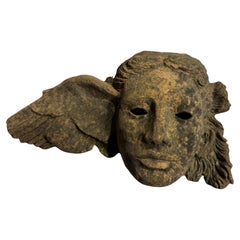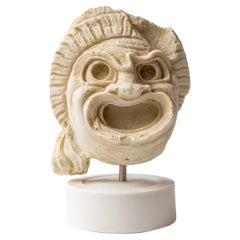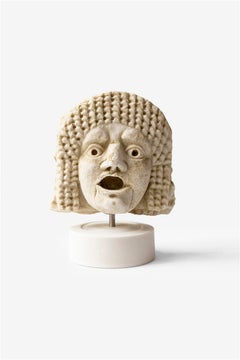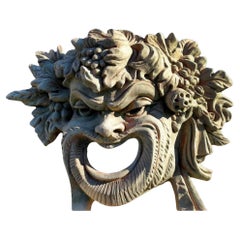Items Similar to Hellenistic Grotesque Theatre Mask of Maccus
Video Loading
Want more images or videos?
Request additional images or videos from the seller
1 of 10
Hellenistic Grotesque Theatre Mask of Maccus
$150,000
£113,738.52
€130,496.76
CA$213,431.63
A$231,525.11
CHF 121,748.83
MX$2,817,192.52
NOK 1,522,056.55
SEK 1,435,486.24
DKK 974,325.42
About the Item
Grotesque theatrical mask of Maccus
Late Hellenistic or Early Imperial period, circa 1st century B.C. – 1st century A.D., likely from Southern Italy.
Terracotta with remains of pink and white pigment
Measure: Height: 20 cm.
With old label reading '‘n° 45''
This highly expressive terracotta mask is incredibly well-preserved, perhaps the best of all known masks of the Maccus type. It depicts a man with grotesque, comically deformed features. The face is broad with protruding ears, the hook-shaped nose is large and crooked, and the grimacing, gaping mouth reveals the figure’s bottom teeth. The eyebrows are frowning, accentuating the wrinkled forehead, and the man has a hunch on top of his bald skull. Holes have been pierced through the forehead and on each side of the mask, by which it would once have been attached, to a plinth or wall, as a hanging decorative object.
Under the influence of Greek settlers, a vibrant theatre tradition was established in and around the Southern Italian peninsula from at least the fifth century B.C. The comic genres focusing on social satire and mockery were particularly popular amongst both Greeks and native Italic people. In the Greek colonies, a new genre of farce was developed in the 4th century B.C. - the Phlyax plays, a form of mythological burlesque blending figures from the Greek pantheon with tropes borrowed from Athenian New Comedy. One of the most popular characters was Maccus, a bald, hunchbacked, crooked-nosed, and large-eared peasant, driven and derided by greed, whose physical description is reminiscent of the present mask. It was this genre of comedy that, through contact between the Southern Italian Greeks and their neighbours to the North, would later become beloved by the Romans.
It is important to note that stage performers did not wear masks in terracotta. Rather, they wore masks fashioned out of perishable materials such as wood, linen, or leather. Terracotta masks such as this one were modelled after these and deposed in sanctuaries or used as garden decoration. The use of masks as decorative ornaments testifies to the popularity of the dramatic arts in Rome and a strong aesthetic appreciation for theatre costumes. Indeed, props such as masks strongly enhanced the audience’s visual and aesthetic experience. As such, they were undoubtedly part of why farces were so loved by the public and thus became iconic elements of Roman public and cultural life. Depictions of theatrical scenes, actors, and masks can be found across the Roman arts, from sculptures to mosaics, frescoes, and reliefs, decorating both private and public buildings throughout the Empire.
Provenance:
- From the collection of Louis-Gabriel Bellon (1819-1899), Saint-Nicolas-lez- Arras and Rouen, thence by descent.
- Dimensions:Height: 7.88 in (20 cm)Diameter: 7.49 in (19 cm)
- Style:Classical Roman (Of the Period)
- Materials and Techniques:
- Place of Origin:
- Period:
- Date of Manufacture:circa 1st Century B.C.-1st Century A.D.
- Condition:
- Seller Location:London, GB
- Reference Number:Seller: 429731stDibs: LU1052232061902
About the Seller
5.0
Recognized Seller
These prestigious sellers are industry leaders and represent the highest echelon for item quality and design.
Gold Seller
Premium sellers maintaining a 4.3+ rating and 24-hour response times
Established in 2007
1stDibs seller since 2014
103 sales on 1stDibs
Typical response time: 7 hours
Associations
LAPADA - The Association of Arts & Antiques DealersInternational Confederation of Art and Antique Dealers' AssociationsThe British Antique Dealers' Association
- ShippingRetrieving quote...Shipping from: London, United Kingdom
- Return Policy
Authenticity Guarantee
In the unlikely event there’s an issue with an item’s authenticity, contact us within 1 year for a full refund. DetailsMoney-Back Guarantee
If your item is not as described, is damaged in transit, or does not arrive, contact us within 7 days for a full refund. Details24-Hour Cancellation
You have a 24-hour grace period in which to reconsider your purchase, with no questions asked.Vetted Professional Sellers
Our world-class sellers must adhere to strict standards for service and quality, maintaining the integrity of our listings.Price-Match Guarantee
If you find that a seller listed the same item for a lower price elsewhere, we’ll match it.Trusted Global Delivery
Our best-in-class carrier network provides specialized shipping options worldwide, including custom delivery.More From This Seller
View AllRoman Marble Head Fragment
Located in London, GB
This fine Roman marble head fragment, with broad nose, soft lips, and bearded chin, captures the likeness of one of the most important playwrights of...
Category
Antique 15th Century and Earlier Italian Classical Roman Busts
Materials
Marble
Roman Marble Head of a Satyr
Located in London, GB
Head of a Satyr
Roman, circa 2nd - 3rd century AD
Carved and highly polished marble
An extremely fine marble head of a satyr, depicted with ivy wreath, curly hair and pointed goat’s ear, the full lips slightly parted to reveal the creature’s clenched teeth.
The head was once part of a relief with visible fragmentation on the left side. Almost completely worked in the round and carefully polished, the skill of the sculptor is particularly remarkable given the confined working space available for a relief carving, such as this.
The Roman Imperial Period marked the expansion of the political and cultural influence of the Roman Empire. The period began with the reign of Augustus in 27 BC, immediately following Caesar’s assassination which ultimately ended Rome’s time as a republic. Soon after, Augustus’ defeat of Anthony and...
Category
Antique 15th Century and Earlier Busts
Materials
Marble
Cypriot Bronze Age Terracotta Plank Idol
Located in London, GB
This extremely well-preserved, stylised Cypriot plank idol is an iconic form of human representation from Bronze Age Cyprus. Made from burnished earthenware with lime-filled incision...
Category
Antique 15th Century and Earlier Cypriot Prehistoric Abstract Sculptures
Materials
Terracotta
Ancient South Arabian Alabaster Statue
Located in London, GB
South Arabian Calcite female figure
3rd Century BC to 1st century A.D.
Calcite Alabaster
height: 30.5 cm
A magnificent alabaster female figure, a f...
Category
Antique 15th Century and Earlier Yemeni Figurative Sculptures
Materials
Alabaster
Roman Marble Statuette of Jupiter
Located in London, GB
Roman Marble Fragment of jupiter
Circa 2nd-3rd Century A.D.
Measure: Height: 19.7 cm
This beautiful Roman fragmentary statuette depicts Jupiter, the king of the gods, here recognisable from his two chief attributes, the eagle with outstretched wings - according the Pseudo-Hyginus, singled out by Jupiter because ''it alone, men say, strives to fly straight into the rays of the rising sun'' - and the base of the scepter, which remains at the side of the left foot, an aspect likely borrowed from the statue of Zeus at Olympia, once one of the Seven Wonders of the World. Though much of the original piece has been lost, the subtle anatomical detail in the feet mark this out as a piece of exceptional quality, and the work of an artist of particular talent and patience - as Johann Winckelmann once said of the famous Belvedere Torso, ''if you contemplate this with a quiet eye [...] the god will at once become visible in this stone.''
This fragment once caught the eye of Henry Howard, 4th Earl of Carlisle (1694-1758), a Knight of the Garter and among the most prolific collectors of his day. The piece, acquired during his travels to Rome, was proudly displayed on an alcove of the Western Staircase of Castle Howard...
Category
Antique 15th Century and Earlier Italian Classical Roman Figurative Scul...
Materials
Marble
Roman Marble Foot
Located in London, GB
Roman marble Fragment of a Right Foot with Sandal
Circa 1st - 2nd Century A.D.
An evocative Roman marble fragment, preserving the front portion of an over-lifesized sandalled foot. The toes, nails, and bridge of the foot have been sensitively carved. The outer sole of the sandal remains, with delicate, pointed straps joining between the first two toes in a diamond shape.
This fragment once belonged to Danish sculptor Jens Adolf Jerichau...
Category
Antique 15th Century and Earlier Italian Classical Roman Figurative Scul...
Materials
Marble
You May Also Like
"THE NIGHT HIPNOS" Italian Terracotta Mask 20th Century
Located in Madrid, ES
"THE NIGHT HIPNOS" Italian Terracotta Mask 20th Century
40cm x 20cm
THE NIGHT - PRIMORDIAL DIVINITY
According to the Orphic tradition (from Orpheus singer and musician, son of Eagr...
Category
20th Century Italian Modern Figurative Sculptures
Materials
Terracotta
Ancient Roman Theatre Mask Myra No:II Museum Replica Cultured Marble
By LAGU
Located in İSTANBUL, TR
It was found in the ancient city of Myra in Antalya, Turkey. It was used as a mask in theaters during the Roman period.
The city of Myra, one of the six most important cities that w...
Category
2010s Turkish Classical Greek Masks
Materials
Statuary Marble
Ancient Roman Theathre Mask Myra Bust Decorative Statue No:I Museum Replica
By LAGU
Located in İSTANBUL, TR
It was found in the ancient city of Myra in Antalya, Turkey. It was used as a mask in theaters during the Roman period.
The city of Myra, one of the six most important cities that w...
Category
2010s Turkish Classical Greek Busts
Materials
Statuary Marble
ANCIENT ROMAN MASk
Located in Madrid, ES
COPY OF AN ANCIENT ROMAN MASK MADE IN TERRACOTTa
Category
Vintage 1970s Mounted Objects
Materials
Terracotta
$3,121
20th Century Italian Stone Fountain Mask
Located in Milano, MI
This antique stone mask was probably used in a fountain. It is a very decorative Italian antique object. The mask fits as decorative object on a bureau o...
Category
Early 20th Century European Classical Roman Animal Sculptures
Materials
Stone
Composition Mask of Mythical God
Located in Round Top, TX
Composition mask of a classic mythical face.
Category
Antique Early 1900s Italian Figurative Sculptures
Materials
Composition
